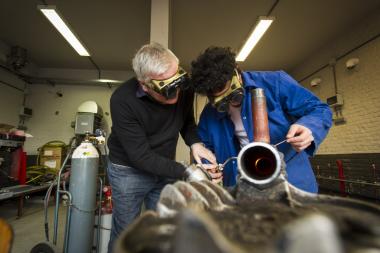
Providing students with modern training tools which are adapted to the world of employment: this is the goal of Brussels’ six Centres for Advanced Technology, which are supported by the European Union
2013-04-05 – The idea of the Centres for Advanced Technology, better known as CTAs, is to make available to students modern training tools which are adapted to the world of employment. For optimal impact on their target group, the CTAs are located in technical and professional teaching establishments. Six CTAs have been created in the Brussels Region, thanks to funding from the French Community of Belgium and the European Regional Development Fund (ERDF), in such diverse fields as chemicals, industrial automation, residential and industrial electricity, childcare and nursing, computer animation and the graphic industry, and finally green and renewable energies.
The term ‘Centre for Advanced Technology’ may conjure up a picture of gleaming buildings containing an array of sophisticated technologies. This is not the case at the CTA for green and renewable energies in Anderlecht, but it is none the worse for it. The premises fitted out on the third floor of the Institut Notre-Dame are above all functional. Rather than razzamattazz, there is pragmatism. The approach of the training courses is primarily practical in nature, adapted to realities on the ground and useful both for the teachers who come here for training and for the pupils.
Training trainers
This immersion in the world of energy takes place between the Gare du Midi railway station and the Canal, just a stone’s throw from one of the exits from the Clémenceau metro station. Olivier Dehantschutter, the CTA’s coordinator, shares his passion here for different types of heating. The hours he has spent dismantling and repairing boilers are evident from his handshake. He is a tall man, and this lends some added force to his moral authority in this project.
“The conversion work started here three years ago,” he explains, “and will soon be completed. Mind you, courses have been going on here for several years now.” He pushes open the door to the first room. A group of adults are busying themselves around computers and electronic cards. “Above all, we need to train the trainers,” the coordinator calls out. “Here, teachers who have come to receive training are learning about the use of electrical circuits with various kinds of energy: photovoltaic, wind, fuel cells, and so on. The programme enables them to make progress intuitively, like in a computer game, as they discover the new subject matter, so that they can then teach it to their pupils.”
Supporting conventional schools
The CTAs provide support for more conventional schools and forms of education. Above all, they offerexposure to real-life practice in the field, in both conventional school education and continuing professional training. Olivier Dehantschutter stresses: “I’m a self-employed boiler technician myself: I know what future graduates from the centre need to be able to do”. In addition to the new equipment acquired when the CTA was installed, the coordinator also provides students, through his contacts, with older parts and models to be dismantled, repaired, regulated and understood, to avoid embarrassment in real-life call-out situations.
The tour continues. From room to room, the energy production sources vary: pellets, gas, fuel oil, but also photovoltaic and thermal solar panels, fuel cells, heat pumps, cereals and even oilseed rape… The energy produced during tests and exercises is stored and used to supply the school. Even the wall spaces between two classrooms are fitted with a series of radiators, among other things: they are among the circuits that the students need to be able to connect up and get working.
Involving the pupils
At first sight, the premises seem unfinished, like some permanent building site. In fact, this is because one of the CTA’s activities is to also involve pupils in the construction of a heating system. They need to learn to make all kinds of connections: for energy input, combustion gas output, to radiators and to other heat distribution systems.
Established in the heart of Anderlecht, the CTA for green and renewable energies is open to all schools in the Brussels Region. Requests for training also come in from places as far afield as Namur and Ath. A centre like this does not like to be unused: provided there are free time-slots, the various requests can be satisfied.
Installations built by the pupils
Besides heating, a refrigeration system is also dismantled at the CTA to enable the cold cycle to be understood. The heat pump, on the other hand, shows how energy can be extracted from one place to be injected in another, in the form of heat in the winter and air-conditioning in the summer. The installations are often created by pupils in the fifth and sixth grades, while those in the seventh check the younger pupils’ work.
Several types of solar panels are also basking under a long-awaited blue sky. They are used to supply power to various installations, but set up side by side in this way they can also be used to study the comparative efficiency of the different systems.
Not far away, at the Institut des Arts et Métiers, two other CTAs have been set up: the CTA for residential and industrial electricity and the CTA for computer animation and the graphic industry. The remaining CTAs are successfully operating in the Canal area, between Molenbeek (Athénée Serge Creuz – industrial automation), Schaerbeek (Institut Frans Fischer – chemicals), and Brussels (Collège La Fraternité – childcare and nursing). All of which should help bring dynamism to these fast-changing districts.
Jean-Pierre BORLOO








